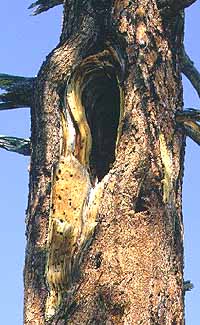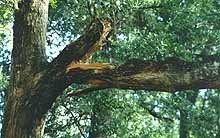Home > Tree structure basics > Strength of different parts > Branch vs. trunk wood
Branch vs. Trunk Wood
- It is not known whether branch wood is weaker than trunk wood. Branches break
in storms from either a downward force, twisting, or an upward force. They appear
to be especially susceptible to breakage from the unaccustomed upward or twisting
force than from wood weakness. Folks that study this are not clear on which
is most common.
What is clear is that when a branch is twisted or pushed up in the wind it can break easily. This occurs because compression wood under the branch of conifers is not strong in tension. Wood under the branch is placed in tension and breaks fairly easily when the branch is pushed up. Tension wood on top of a hardwood branch is not strong in compression so wood on top splits and fails when a branch is pushed up. - Branches can fail by pulling out of their sockets (left photo). This respresents a weakness in the branch union, not a weakness in the wood.
- Branches, especially those along the lower trunk, can progressively bend under their own weight and fail (right photo).
- Summer branch drop is a phenomona known to occur on certain trees soon after a rain following an extended dry period. There are theories as to the cause of this failure. Cracks may develop along the rays and perhaps in other locations in the wood as it dries during the drought. As the tree re-hydrates after it rains, the wood becomes very heavy and can not be supported by the wood because it now contains cracks.



